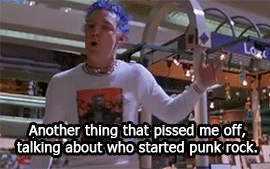The Native Music Project is an exploration of underground music scenes within indigenous communities throughout North America. Instead of using a traditional film format, like most documentaries, this project attempts to record the history and presence of modern indigenous musicians through the use of new media. This project allows for participation from subjects and viewers via commentary and submission through three key elements: an interactive map, a wiki glossary, and a blog.
The Audience – The Native Music Project, in its current state, is more or less a prototype. My intention is reach out to indigenous-identified musicians and fans with the hopes that they participate by adding to the map and glossary or by leaving comments throughout the site. In “Documentary Uncertainty,” Hito Steyerl discusses how the documentary production “has functioned in the service of a large-scale epistemological enterprise that is closely linked with the project of Western colonialism.” In other words, it has often contributed to depictions of indigenous people that justify their colonization, either by portraying them as helpless or complicit in their own oppression, and this is uncritically passed off as the “truth.” By redistributing authority over production amongst the documentary’s “viewers,” this work seeks to challenge the notion of objective truth obtained from the outside.
The Map – The Native Music Project’s interactive map is powered by ZeeMaps, a free online mapping program. ZeeMaps was chosen primarily because of it’s crowd-sourcing potential. I introduced the map with an initial 75 entries, based on my own knowledge and research, with each marker indicating the location of an artist or band with at least one indigenous-identified member. Any visitor of the site can add entries simply by clicking the “Add” button. My intention is to provide a space for an ever-growing account of indigenous involvement in the creation of contemporary music and accompanying underground scenes. This interactive element is the cornerstone of this project. I know there is a significant history of misrepresentation and misappropriation of indigenous culture, lands and bodies, especially with regards to academic research. Because of this, it was important to me to create a platform where so-called “subjects” could instead become participants in the documentation of their own history.
Currently, the map showcases four overarching genres; it does not currently account for sub-genres (this may be readjusted as the project evolves). Because this project is theoretically concerned with the formation and politics of music-based sub-cultures, I have allowed for the map to display separate layers for each genre. I am interested in how these subcultures, especially Punk and Hip Hop, have been conceived in social discourse as primarily race-driven and yet indigenous voices and perspectives are often ignored, despite their obvious presence. As I discuss in one of my blog posts, indigenous scholar Andrea Smith calls this kind of dismissal of Native peoples as “genocidal logic” – it is the underlying premise of colonialism, in that it conceives of indigenous people as always and already extinguished. The primary objective of this project is to unravel the legacy of genocidal logic and demonstrate how indigenous culture exists within a contemporary (and hybrid) context.
The Glossary – The glossary appears in wiki format, so that any user can edit and add to entries. I initiated the glossary with brief definitions for ten key terms that are used either throughout the site or by featured artists found on the map. They include definitions of sub-genres and colloquial terms within indigenous cultures. Again, the intention is for participants to build upon and adapt the current framework set in place.
The Blog – While the intention of this project is to provide a platform for subject-driven creation, it would be naïve to assume that the voice of the artist could ever be invisible. The blog features entries by myself, the artist/director of Native Music Project, as I negotiate with my role in this project and related theoretical/political issues. The intention is to provide context for my personal motivations behind publishing the site and to create the opportunity for participants to engage in discussion with each other and myself directly.
In “Drifting Through the Grid: Psychogeography and Imperial Infrastructure,” Brian Holmes suggests that “we should conceive the worldwide communications technologies as Imperial infrastructure.” This is an important concept to reflect upon, especially considering that this technology, these maps, and the borders contained therein, were designed by and through the process of colonization. Yet, Jesse Shapins, in “Mapping the Urban Database Documentary,” points out that “explor[ing] artistic avenues opened by new technologies does not mean we have to embrace the use-assumptions of the technology’s producers.” We should not ignore the colonialist context within which this project and most likely its participants exist, but much like a remix, this project works within an established (albeit problematic) format with the intention of confronting its limitations and exploring new modes of creative expression.
————————————————————
References
Holmes, Brian. “Drifting Through the Grid: Psychogeography and Imperial Infrastructure,” available at http://www.springerin.at/. Web. May, 15, 2014.
Shapins, Jesse. “Mapping the Urban Database Documentary,” Urban Geographers: Independent Filmmakers and the City, ed. Mark Street. Berghahn Books, 2011. Web. May, 15, 2014.
Smith, Andrea. “Indigeneity, Settler Colonialism, White Supremacy.” Global Dialogue. 12.2 (2010). Web. May, 15, 2014.
Steyerl, Hito. “Documentary Uncertainty.” Re-Visiones. 1(2011). Web. May, 15, 2014.



